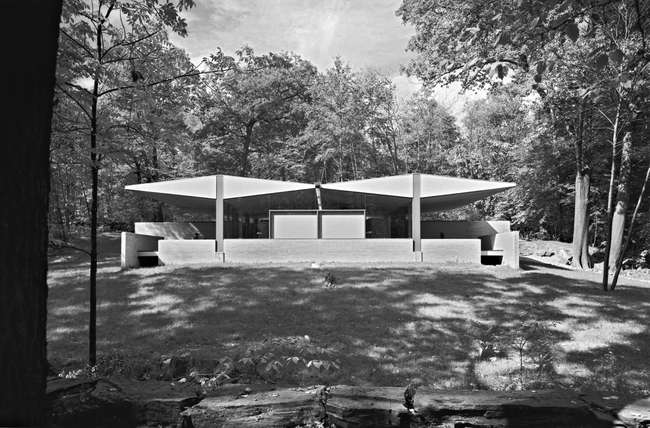
Ulrich Joseph Franzen, a prominent New York architect in the latter part of the 20th century, died after a brief illness on October 6 in Santa Fe, New Mexico, at the age of 91. After studying at the Harvard Graduate School of Design in the mid-1940s when Walter Gropius was its chair of architecture, Franzen became part of a cohort that would disseminate the Modernist vocabulary of the Bauhaus founder in the U.S. during the boom period after World War II.
 |
| Photo courtesy of the Houston Chronicle Franzen in front of the Alley Theater in Houston, Texas (1968) |
Most of the Gropius generation—which included Paul Rudolph, Philip Johnson, I.M. Pei, and John Johansen—initially made its mark designing houses. Franzen’s own house in Rye, New York, was featured in the first Record Houses issue in 1956. The floating parasol-like roof with a pair of attenuated, diamond-shaped forms made it distinctive: it has been compared to Le Corbusier's diagrammatic design for the Porte Maillot exhibition pavilion in Paris (1950) that he later developed for the Heidi Weber Pavilion (1965) in Zurich. In 2005 Franzen received the AR50 Award for the house as part of the celebration of the 50th anniversary of Record Houses, which coincided with the exhibition Forever Modern: 50 Years of Record Houses, at the Pratt Manhattan Gallery.
Franzen established his own office in New York in 1955, which soon became known for hiring "lively, interesting people," recalls James Stewart Polshek, who worked for Franzen for four years in the late 1950s. "He always encouraged younger talent," Polshek says. The houses led to larger projects such as the office interiors in 1959 of the Philip Morris Companies in New York City. (Franzen would later design its headquarters in 1984.) Polshek, who worked on the Philip Morris office interiors at 101 Park Avenue recalls that "Rick was really rigorous," with a design that today looks straight out of Mad Men. "You would get calls from him at midnight or 6 in the morning if something didn’t line up," Polshek remembers. "But he pushed me and taught me."
By the 1960s, Franzen had also become the guiding spirit of the Architectural League of New York, where he was president from 1966 to 1968 and subsequently acted in an unofficial capacity as its godfather. "Rick made the League an exciting place," says Robert A.M. Stern who was League president from 1973 to 1977. "He did amazing things, such as bringing exhibitions by avant-garde artists like James Lee Byars and Alan Sonfist to the League, and sponsoring John Margolies’s exhibition on Morris Lapidus: Architecture of Joy (1970)." (The Lapidus exhibition was controversial at the time, causing critics such as Sibyl Moholy-Nagy to write vituperative letters to the League.) Franzen’s design for the shop Paraphernalia fit the artistic spirit of the time, Stern points out, referring to the boutique that featured black interiors and rear projection images when it opened in 1969 at 659 Lexington Avenue.
Franzen’s Alley Theater in Houston (1968), a muscular concrete Brutalist-style building that was well received by the media, officially put him on the map as an architect who would be soon specializing in cultural and educational institutions and office buildings. The Veterinarian Research Tower at Cornell University in Ithaca, New York (1974), Hunter College in New York City (1984), and the Philip Morris Headquarters across from Grand Central Terminal (1984) were only some of the many large-scale projects for which Franzen was well-known. One of Franzen's most successful projects was the Champion International building in Stamford Connecticut (1983), an elegant, stringently modest rectilinear office building. It's only problem was being located in a city where the sci-fi kitsch of architect Victor Bisharat ruled. It got lost among the urbanistic clamor, something with which Franzen’s quieter, more stolid architecture often had to contend.
Franzen was born in Dusseldorf, Germany, and received his undergraduate degree from Williams College. He is survived by his wife Josephine, two sons, Peter and David, a daughter, April, and three grandchildren.


Post a comment to this article
Report Abusive Comment